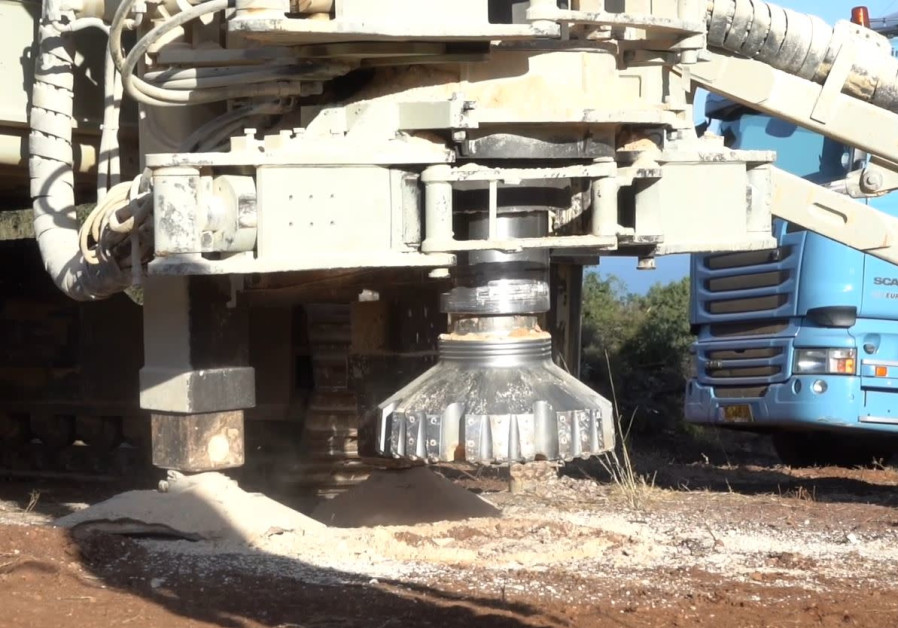Operation Northern Shield expected to take weeks to complete

Preparations for ‘Operation Northern Shield’ to destroy Hebollah terror tunnels . (photo credit: IDF SPOKESPERSON’S UNIT)
Operation Northern Shield, which was launched to to expose and destroy Hezbollah tunnels along the border fence with Lebanon, is expected to continue for several weeks and the state of high alert in the North will continue, according to Israeli media reports Wednesday.
Presently, the IDF estimates that the operations will remain in Israeli territory.
The work is being carried out by the IDF’s engineering forces and fighters from the Yahalom unit, an engineering unit designated for special missions, using heavy engineering machines and other technologies.
The territory by the northern border, unlike the South where Hamas tunnels are located, is rocky, and the IDF’s engineering work to uncover and neutralize the tunnels is complex. For example, the first exposed tunnel was some 25 meters deep, and its complete destruction requires many days.
“It is reasonable to assume that digging tunnels through rocks in the Galilee mountains, at a depth of 15 to 30 meters, takes years,” Dr. Maor Cohen, an expert on geography and the environment, told The Jerusalem Post‘s sister publication Maariv.
“The land in the hills of Galilee is very hard and not conducive for digging tunnels. These are limestone rocks, not soft sandy soil like by the Gaza border,” Cohen explained.
“Digging in limestone can not be done using manual digging tools,” Cohen said. “It is reasonable to assume that the excavators used mechanical tools, which were apparently the source of the noise that residents of the communities on the Lebanese border had been reporting for years. In the Gaza border region, on the other hand, it was more difficult to hear the noise of the digging due to the use of manual tools in sandy soil.”
Cohen pointed out that there is a significant advantage to digging tunnels in the North, compared with digging in the South.
“In the Gaza Strip, the sandy soil crumbles immediately after digging and needs to be reinforced immediately before it collapses,” he said. “It’s also impossible to dig too deep in the Gaza Strip due to the groundwater.”
While Israeli defense officials have repeatedly denied the existence of cross-border Hezbollah tunnels, the military admitted that it has been aware of Hezbollah efforts to build attack tunnels stretching into Israel at several points along the border since the Second Lebanon War in 2006.
The military believes that Lebanon’s Hezbollah – referred to by many as an army rather than a terror group – is the most significant strategic threat. It has gained immeasurable battlefield experience from fighting in Syria, and its organizational growth is cause for concern to the IDF.
Backed by Iran, Hezbollah is also working to establish factories in Lebanon to build precision rockets and missiles that could strike strategic sites in Israel. The Shia terror group possesses more than 100,000 rockets and missiles.
Israel would have trouble contending with barrages of accurate rockets onto the home front, even with its various air defense systems. Just two weeks ago, Israel’s Iron Dome Missile system was unable to protect the South entirely, when more than 20 rockets, out of nearly 400, hit urban centers.
It will likely take several days for Hezbollah leader Hassan Nasrallah to conduct a full assessment and decide whether to respond or not. But according to defense establishment officials, despite his frequent threats against Israel, Nasrallah is not interested in a war at this point.
Nevertheless, the near complete removal of Islamic State and various rebel groups in Syria has allowed Hezbollah to refocus its energy and resources on a potential conflict with Israel.
If Hezbollah does try to stop or interfere with the IDF’s work, by either firing rockets deep into Israeli territory or using a tunnel to infiltrate an Israeli community or military post, there may be no way to stop the Third Lebanon War.
Anna Ahronheim contributed to this report.
Join Jerusalem Post Premium Plus now for just $5 and upgrade your experience with an ads-free website and exclusive content. Click here>>






Comments are closed.